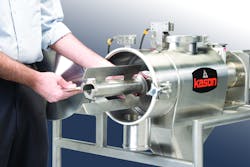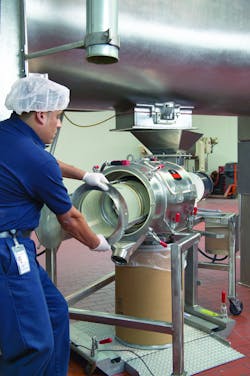Most processing applications require some level of cleanliness and frequency of inspection, so when it comes to processing equipment for food, beverage and pharmaceutical products, the highest levels of cleanliness, regulatory compliance and ease of inspection are necessary to achieve superior reliability in sanitary applications. Screeners and sifters are integral to production in these facilities, so choosing and specifying the most appropriate equipment contributes to overall process success while meeting or exceeding company, industry and governmental regulatory requirements.
When selecting sifting and screening equipment it is important to ensure compliance with applicable regulations and to offer the best designs for processing, inspecting and cleaning. This article will discuss considerations for selecting screening equipment for sanitary applications.
Regulatory considerations
Compliance with regulatory standards is crucial for safe and clean operation. Dependable equipment selection reduces downtime disruption and potential for product recalls. Across the globe, standards to which sifters, screeners and other process equipment may be held include cGMP, USDA, 3-A, FDA, BISSC, CE, CSA, UL, ATEX and others. Identifying the applicable regulatory needs is a key consideration in selecting the right equipment. Some of those considerations include:
- 3-A sanitary standards maintain a large inventory of design criteria for equipment and processing systems developed using a modern consensus process based on ANSI requirements to promote acceptance by the USDA, FDA and state regulatory authorities. 3-A authorization for equipment affirms the integrity of hygienic processing equipment for the food, beverage and pharmaceutical industries.[1]
- CE mark must be applied for any equipment that ships to Europe, especially. CE marks signify that products have been assessed to meet high safety, health and environmental protection requirements for products that are sold in the European Economic Area. This mark differs from other regulatory marks because they can be self-certified by manufacturers, meaning that a third-party certification organization is not involved in the process but rather act as a declaration of meeting European requirements.[2]
- ATEX is a directive from the European Union that applies to atmospheres that are potentially explosive due to dust, vapor or gases that can ignite. Equipment that is intended for use in any environment that could potentially be explosive must meet specific requirements for its group and category. In addition to regulations for equipment, companies using the equipment must also comply with workplace safety regulations laid out by ATEX.[3]
- BISSC is the Baking Industry Sanitation Standards Committee. BISSC certification ensures that equipment manufacturers conform to the specific criteria laid out in ANSI/ASB/Z50.2-2013 and are verified by a third party. The criteria for BISSC standards are general principles for the design, construction and cleaning for all bakery equipment.[4]
- CSA Group tests, inspects and certifies a range of products for the U.S., Canada and worldwide. For ultra-sanitary equipment, CSA certifications are most applicable to commercial appliances used in cooking, food service or food preparation.[5]
- cGMP stands for current good manufacturing practice regulations and are overseen by the FDA as part of monitoring drug manufacturing to meet requirements for manufacturing, processing and packaging of drug products. cGMP approval is necessary for equipment used in U.S.-based pharmaceutical processing facilities.[6]
Additional regulations may apply to processing equipment depending on the exact use and location. So, when specifying screeners or sifters, be sure to include regulatory research as an early step in the product selection process.
The quality standards for the company using the equipment must also be considered. Often the specific regulatory compliance certifications will indicate compliance with the standards of the company, but additional standards may also apply.
Equipment construction
When considering the construction of a sifter or screener, form, fit and finish all contribute to the ability to maintain sanitation. When specifying a new screener, consider the following elements of equipment construction:
1. Material of construction. 304 stainless steel is the standard material for sifters and screeners. 316 stainless steel becomes necessary where products or cleaners include chlorides, acids, bases and other harsh solvents. Nickel-based or more exotic alloys may be employed where higher concentrations of these cleaners and harsh solvents exist.
2. Finish. Surface finish is important for product quality and equipment longevity. A 2B finish is the most widely used stainless steel finish in chemical and food applications. Other finishes that may be appropriate for ultra-sanitary processing include #4, #7 or mirror finish. The highly polished surfaces and weld finishing eliminate areas for bacteria growth. These finishes also promote material flow through equipment to reduce product irregularity.
3. Shape. Sifters and screeners are typically rectangular (or square, with right angles), circular or cylindrical. The geometry of screeners and separators can promote material flow through the machine. Rounded designs and elimination of corners, crevices and crawl spaces important in sanitary design can be simplified through choices in the outward shape of equipment. These form choices also promote cleaner operation for quicker, easier cleaning.
Consider new over used equipment
Processing equipment can be a major expense, so price sometimes becomes a primary driver that distracts from overall goals during the equipment selection process. This can create a trap in selecting a screener or separator that may not meet desired specifications or process needs when one is locked into a specific machine. Without knowledge of the installation history of used machines, modifications made over time and products run on them — more questions arise than can be safely answered by a manufacturer.
When purchasing new equipment, many manufacturers — including Kason Corporation — provide free sample testing to verify equipment performance for a specific application. Machines can also be purchased on a “try before you buy” basis to confirm the new equipment will produce the necessary output and material quality. Factoring in a trial scenario as part of the “new vs. used” purchase decision often makes sense in selecting just the right screener for the facility.
Partner wisely
When sourcing sifters or screeners there are a variety of considerations. Specifically, for food, pharmaceutical or other ultra-sanitary operations, certifications, design and new equipment are the top considerations that must be taken into account in order to ensure clean processing.
Partnering with the right manufacturer is also an important decision in the specification process. Work with equipment manufacturers who understand and have experience with the most stringent sanitary and safety standards and regulations, especially the ones that apply specifically to the operation. Do not take a risk with inexperienced or unqualified equipment suppliers for these critical applications.
References
[2] https://ec.europa.eu/growth/single-market/ce-marking_en
[3] https://www.ul.com/offerings/atex-certification-european-union
[4] http://www.bissc.org/about.html
[5] https://www.csagroup.org/testing-certification/product-areas/appliances/commercial-appliances/
[6] https://www.fda.gov/drugs/pharmaceutical-quality-resources/current-good-manufacturing-practice-cgmp-regulations
Jim Ling is the North American Sales Manager at Kason Corporation. Kason is a leading manufacturer of screening, sifting and separating equipment and circular fluid bed dryers, coolers and moisturizers for powder and bulk materials, ranging from dry or moist solids to solids-laden slurries.
About the Author
Jim Ling
North American Sales Manager at Kason Corporation
Jim Ling is the North American Sales Manager at Kason Corporation. Kason is a leading manufacturer of screening, sifting and separating equipment and circular fluid bed dryers, coolers and moisturizers for powder and bulk materials, ranging from dry or moist solids to solids-laden slurries.



![U 1221 0340 Hi Flat Cmyk[1] U 1221 0340 Hi Flat Cmyk[1]](https://img.processingmagazine.com/files/base/ebm/pcm/image/2020/07/U_1221_0340_hi_FLAT_CMYK_1_.5f1b394535735.png?auto=format,compress&fit=max&q=45?w=250&width=250)